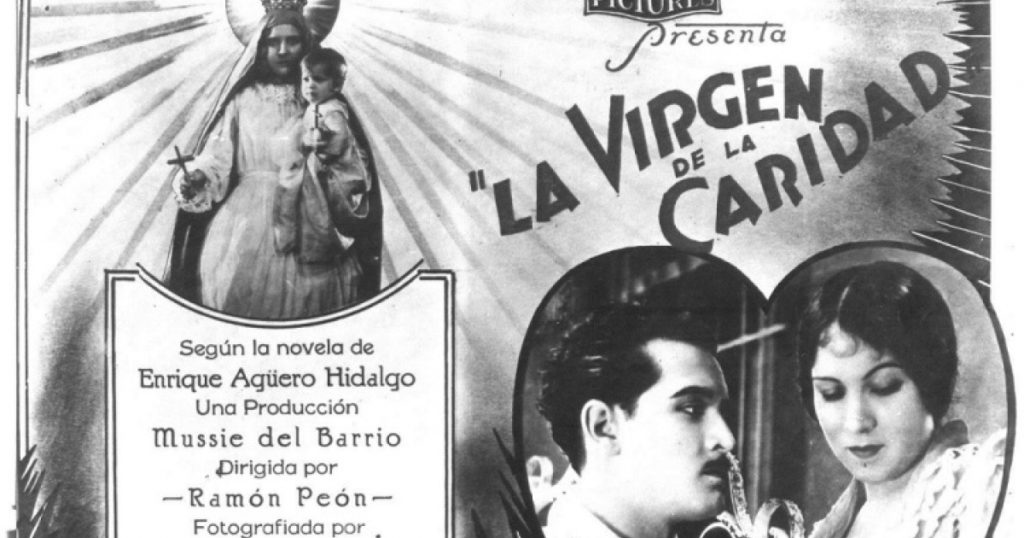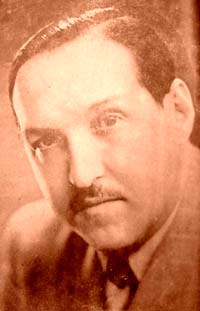 MEMORIAS DE UNA VIEJA CAMARA: “LA VIRGEN DE LA CARIDAD” DE RAMÓN PEÓN.(Pelicula Silente 1930)
MEMORIAS DE UNA VIEJA CAMARA: “LA VIRGEN DE LA CARIDAD” DE RAMÓN PEÓN.(Pelicula Silente 1930)
Hace hoy 88 años (8 de septiembre de 1930) que fue estrenado en el cine Rialto de La Habana el largometraje de Ramón Peón ‘La Virgen de la Caridad’, versión de la novela homónima de Enrique Agüero Hidalgo. Como expresan los investigadores Arturo Agramonte y Luciano Castillo en la apasionante biografía que le dedicaran al cineasta, ésta terminó siendo “la película que cerró el período silente en Cuba, la más importante generada en la Isla por el cine comercial prerrevolucionario y la mejor obra en la prolífica filmografía de Ramón Peón.
https://youtu.be/4lInPjSN3Gc
Cine Silente. “La Virgen de la Caridad” (Fragmento)
Ramón Peón nació en La Habana, Cuba en 1897 y falleció en San Juan, Puerto Rico en 1971 fue Periodista, mago, bailarín, músico, productor, director, camarógrafo, actor y guionista de cine. Se inició como camarógrafo en los antiguos estudios Kalem y Vitagraph, de Nueva York. En 1920 fue asistente de dirección, en Hollywood, de dos comedias cortas tituladas ‘Welcome rotarians’ y ‘The latest from parell’. Después decidió radicar en su país natal, en donde se convirtió en uno de los más fecundos realizadores del cine mudo cubano, al filmar entre 1920 y 1930, doce películas, la última de ellas fue La Virgen de la Caridad.
https://youtu.be/DUs8iErUwJI
Cine Silente. “La Virgen de la Caridad”. (Film Completo)
La importancia de esta cinta no radica en el hecho de que sea la única copia conservada completa de toda la producción silente de ficción, ni siquiera en el hecho de ser la cinta que cierra el ciclo del cine mudo producido en Cuba. Su mérito radica exclusivamente en el hecho de que, entre tanta cursilería y sin abandonar esos patrones, hace un intento de penetrar hasta cierto punto en la realidad del campesino.
Originalmente una novela, la versión fílmica muestra frescura – visto, claro está a la luz de la época, un mensaje dinámico y actuaciones aceptables. Además, aunque éste no haya sido precisamente su propósito, muestra el desalojo, los manejos de los terratenientes para despojar a los campesinos de sus tierras, la vida humilde de nuestros hombres de campo.
Y como apuntára Nestor Almendros, no se trata de un filme religioso. O al menos su historia no está planteada desde la perspectiva hagiográfica. Lo cual nos permitiría examinar a la cinta como parte de algo más complejo, es decir, como parte del esfuerzo que a diario hacemos por encontrar el sosiego personal mientras nos dure la efímera existencia.
¿Quién no se ha sentido alguna vez en esta vida víctima de ese caos que nos rodea?, ¿quién no ha sentido que vive vapuleado por el absurdo y la arbitrariedad?, ¿quién (aún sin creer en Dios) no ha rogado para que tanta villanía y tormentos cesen?
 MEMORIES OF AN OLD CAMERA: “THE VIRGIN OF CHARITY” OF RAMÓN PEÓN. (Silente film 1930)
MEMORIES OF AN OLD CAMERA: “THE VIRGIN OF CHARITY” OF RAMÓN PEÓN. (Silente film 1930)
88 years ago today (September 8, 1930), Ramón Peón’s feature film La Virgen de la Caridad, a version of Enrique Agüero Hidalgo’s novel of the same name, was premiered at the Rialto movie theater in Havana. As researchers Arturo Agramonte and Luciano Castillo express in the passionate biography they dedicate to the filmmaker, it ended up being “the film that closed the silent period in Cuba, the most important one generated on the island by prerevolutionary commercial cinema and the best work in the prolific filmography of Ramón Peón.
Ramón Peón was born in Havana, Cuba in 1897 and died in San Juan, Puerto Rico in 1971. He was a journalist, magician, dancer, musician, producer, director, cameraman, actor and screenwriter, and started as a cameraman in the old studios. Kalem and Vitagraph, from New York. In 1920 he was an assistant director, in Hollywood, of two short comedies entitled ‘Welcome Rotarians’ and ‘The latest from Parell’. Then he decided to settle in his native country, where he became one of the most prolific Cuban silent filmmakers, filming between 1920 and 1930, twelve films, the last of which was La Virgen de la Caridad.
https://youtu.be/DUs8iErUwJI
Silent cinema. “The Virgin of Charity”. (Full Film)
https://youtu.be/4lInPjSN3Gc
Silent cinema. “The Virgin of Charity” (Fragment)
The importance of this film does not lie in the fact that it is the only complete preserved copy of the whole silent production of fiction, not even in the fact that it is the film that closes the silent film cycle produced in Cuba. Its merit lies exclusively in the fact that, among so much cursilería and without abandoning those patterns, makes an attempt to penetrate to a certain extent in the reality of the peasant.
Originally a novel, the film version shows freshness – seen, of course, in light of the era, a dynamic message and acceptable performances. In addition, although this has not been precisely its purpose, it shows the eviction, the maneuvers of the landowners to strip the peasants of their lands, the humble life of our countrymen.
And as Nestor Almendros pointed out, it is not a religious film. Or at least its history is not raised from a hagiographic perspective. This would allow us to examine the film as part of something more complex, that is, as part of the daily effort we make to find personal tranquility while the ephemeral existence lasts.
Who has not ever felt in this life a victim of that chaos that surrounds us? Who has not felt that he lives battered by absurdity and arbitrariness? Who (even without believing in God) has not prayed that so much villainy and torments cease?
Agencies/ Wiki/ Cine Cubano/ Various/ Internet Photos/ YouTube/ Arnoldo Varona/ www.TheCubanHistory.com
THE CUBAN HISTORY, HOLLYWOOD.






